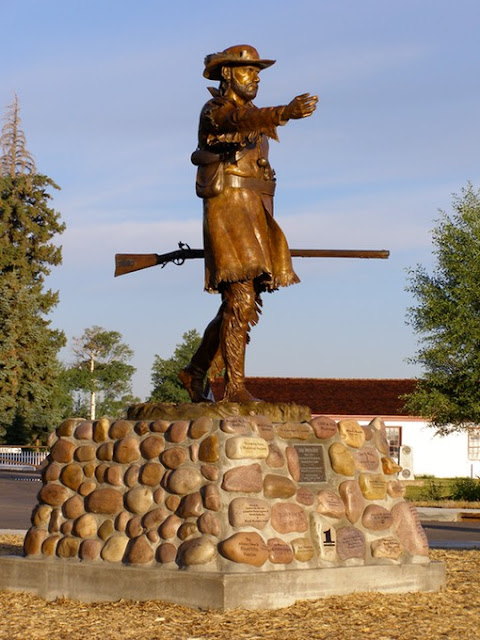Statute of Jim Bridger at the Entrance to Fort Bridger
Two months before Lewis and Clark begin their epic western expedition, Jim Bridger is born in Richmond, Virginia on March 17th, 1804. Twenty years later, Bridger, heading West along the routes Lewis and Clark pioneered, became one of the greatest mountain men of the 19th century.
The son of a surveyor and an innkeeper, Bridger moved with his family to St. Louis in 1818. There, Bridger apprenticed to a blacksmith, learned to handle boats, and became a good shot and skilled woodsman. When the Ashley-Henry fur trading company advertised for “enterprising young men” to travel the Missouri River to trade with the Indians, Bridger was among the first to respond, and he was hired in 1822.
Though he lacked much formal education, Bridger demonstrated a brilliant ability for finding his way and surviving in the wilderness. As part of the Ashley-Henry team, he helped construct the first fur trading post on the Yellowstone River. At the age of 21, Bridger became the first Anglo definitely known to have seen the Great Salt Lake, though he mistakenly thought it was the Pacific Ocean at the time. He was adept at learning Indian dialects and culture, and he had a tremendous memory for geographical detail.
For several years Bridger worked as an independent trapper and in 1830 he joined with three partners to gain control of the Rocky Mountain Fur Company. Bridger never really enjoyed the life of the businessman, though, and he sold out in 1834. That same year, he married Cora, the daughter of a Flathead Indian chief, and she accompanied him on his fur trapping expeditions. Yet by 1840, Bridger had grown tired of the nomadic trapper life. He was convinced that the emigrant traffic through the West had become heavy enough to support a trading post. He founded Fort Bridger along the Green River section of the Oregon Trail, in present-day southern Wyoming.
Fort Bridger quickly became a regular stopping place for overland emigrants, and Bridger happily settled down with Cora, with whom he had three children. Bridger’s idyllic life did not last, though. Cora died, Indians killed one of his daughters, and a second wife died in childbirth. Bridger retreated to the mountains to trap and hunt after each of these tragedies, often living for a time with Indians. In 1850, he married the daughter of a Shoshoni chief, and thereafter he and his bride-whom he called Mary-divided their time between summers at Fort Bridger and winters with the Shoshoni.
In 1853, Mormons, resenting the competition from Bridger’s fort, tried to arrest him as an outlaw. He escaped into the mountains with Mary and his children, but a band of Mormons burnt and gutted the fort, destroying all his supplies. Concerned for his family’s safety, Bridger bought a farm near Westport, Missouri, where he left Mary and the children during all of his subsequent western journeys. He sold Fort Bridger in 1858, and spent the next decade working as a guide and an army scout in the early Indian wars.
By 1868, Bridger’s eyesight was failing, and he increasingly suffered from rheumatism. He retired to his Westport farm, where he cared for his apple trees and no doubt fondly recalled the rugged western mountains he had known so well. He died at the age of 76 on July 17, 1881.


No comments:
Post a Comment